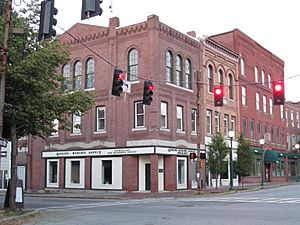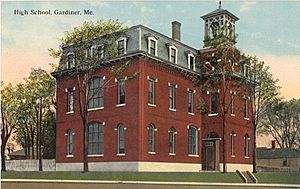Gardiner, Maine facts for kids
Quick facts for kids
Gardiner, Maine
|
||
|---|---|---|

|
||
|
||
| Motto(s):
Moving Forward
|
||

Location in Kennebec County and the state of Maine.
|
||
| Country | United States | |
| State | Maine | |
| County | Kennebec | |
| Incorporated | February 17, 1803 | |
| Villages | Libby Hill South Gardiner |
|
| Government | ||
| • Type | Mayor and council-manager | |
| Area | ||
| • Total | 16.57 sq mi (42.91 km2) | |
| • Land | 15.68 sq mi (40.61 km2) | |
| • Water | 0.89 sq mi (2.30 km2) | |
| Elevation | 30 ft (9 m) | |
| Population
(2020)
|
||
| • Total | 5,961 | |
| • Density | 380.14/sq mi (146.77/km2) | |
| Time zone | UTC−5 (Eastern (EST)) | |
| • Summer (DST) | UTC−4 (EDT) | |
| ZIP Codes |
04345 (Gardiner)
04359 (South Gardiner) |
|
| Area code(s) | 207 | |
| FIPS code | 23-27085 | |
| GNIS feature ID | 0566690 | |
Gardiner is a city in Kennebec County, Maine, United States. The population was 5,961 at the 2020 census. Popular with tourists, Gardiner is noted for its culture and old architecture. Gardiner is a nationally accredited Main Street America community. It is included in the Augusta, Maine micropolitan New England City and Town Area.
Contents
History
Located at the head of navigation on the Kennebec River, Gardiner was founded as Gardinerstown Plantation in 1754 by Dr. Silvester Gardiner, a prominent Boston physician. Dr. Gardiner had made a fortune as a drug merchant, with one apothecary shop in Massachusetts and two in Connecticut, and became a principal proprietor of the Kennebec Purchase within the old Plymouth Patent. He proved a tireless promoter for his development, which once comprised over 100,000 acres (400 km2).
Dr. Gardiner induced a gristmill builder, saw millwright, house carpenter and wheelwright to settle here. Houses, mills, a church and a blockhouse were built. Situated at the confluence of the Kennebec River and Cobbesseecontee Stream, which has falls that drop 130 feet over a mile, the location was recognized by him as ideal for water-powered mills. Gardinerstown, set off from Pittston in 1760, became center of the regional economy.
The wilderness toils of Dr. Gardiner would end, however, with the Revolution. Loyal to the Crown, he fled Boston in 1776 when the British army evacuated. But his settlement lived on without him, and in 1803 was incorporated as the town of Gardiner. From the early 19th century until the Civil War, shipbuilding and trade were primary industries. It would become a city in 1849, at which time ten large riverfront wharves served shipping. Lumber, in vast quantities, passed through Gardiner. Tanneries and shoe factories prospered.
The city became known worldwide for exporting ice. Each winter men cut large blocks from the Kennebec River, then covered the ice with sawdust in warehouses to keep it frozen well into summer. It was loaded year-round on large vessels for shipment throughout the United States and world. Gardiner was noted for its pristine Kennebec ice, harvested at the furthest point upriver that deep-draft vessels could reach.
In 1851, the city was connected by railroad. One of the first workable steam automobiles in America was built in Gardiner in 1858. Beginning in the 1860s, paper mills flourished, as did the commercial ice industry between the 1880s and 1920s. By the 1960s, however, many mills suffered decline and closure. The former mill town is now largely a bedroom community for people who work in Augusta, the state's capital, as well as Bath Iron Works in Bath. Some residents commute as far as the Portland area. The city is endowed with a great deal of antique architecture, much of it beautifully restored. In 1980, the entire downtown historic district became one of the National Register of Historic Places listings in Kennebec County, Maine.
Geography
Gardiner is located at 44°12′21″N 69°47′31″W / 44.205963°N 69.791998°W.
According to the United States Census Bureau, the city has a total area of 16.57 square miles (42.92 km2), of which 15.65 square miles (40.53 km2) is land and 0.92 square miles (2.38 km2) is water. Gardiner is drained by the Cobbesseeconte Stream and Kennebec River.
Climate
This climatic region is typified by large seasonal temperature differences, with warm to hot (and often humid) summers and cold (sometimes severely cold) winters. According to the Köppen Climate Classification system, Gardiner has a humid continental climate, abbreviated "Dfb" on climate maps.
Demographics
| Historical population | |||
|---|---|---|---|
| Census | Pop. | %± | |
| 1810 | 1,029 | — | |
| 1820 | 2,053 | 99.5% | |
| 1830 | 3,709 | 80.7% | |
| 1840 | 5,042 | 35.9% | |
| 1850 | 6,486 | 28.6% | |
| 1860 | 4,487 | −30.8% | |
| 1870 | 4,497 | 0.2% | |
| 1880 | 4,439 | −1.3% | |
| 1890 | 5,491 | 23.7% | |
| 1900 | 5,501 | 0.2% | |
| 1910 | 5,311 | −3.5% | |
| 1920 | 5,475 | 3.1% | |
| 1930 | 5,609 | 2.4% | |
| 1940 | 6,044 | 7.8% | |
| 1950 | 6,649 | 10.0% | |
| 1960 | 6,897 | 3.7% | |
| 1970 | 6,685 | −3.1% | |
| 1980 | 6,485 | −3.0% | |
| 1990 | 6,746 | 4.0% | |
| 2000 | 6,198 | −8.1% | |
| 2010 | 5,800 | −6.4% | |
| 2020 | 5,961 | 2.8% | |
| U.S. Decennial Census | |||
2010 census
As of the census of 2010, there were 5,800 people, 2,487 households, and 1,550 families living in the city. The population density was 370.6 inhabitants per square mile (143.1/km2). There were 2,778 housing units at an average density of 177.5 per square mile (68.5/km2). The racial makeup of the city was 95.4% White, 0.3% African American, 0.7% Native American, 0.7% Asian, 0.4% from other races, and 2.5% from two or more races. Hispanic or Latino of any race were 1.0% of the population.
There were 2,487 households, of which 28.9% had children under the age of 18 living with them, 44.8% were married couples living together, 11.8% had a female householder with no husband present, 5.7% had a male householder with no wife present, and 37.7% were non-families. 29.6% of all households were made up of individuals, and 9.7% had someone living alone who was 65 years of age or older. The average household size was 2.30 and the average family size was 2.82.
The median age in the city was 40.9 years. 21.7% of residents were under the age of 18; 7.4% were between the ages of 18 and 24; 26.3% were from 25 to 44; 30.1% were from 45 to 64; and 14.4% were 65 years of age or older. The gender makeup of the city was 48.8% male and 51.2% female.
Education
Gardiner is part of Maine School Administrative District #11 that serves the communities of Gardiner, Pittston, Randolph and West Gardiner. The district operates five elementary schools, a middle school, and high school. The following schools are located in Gardiner:
- Gardiner Area High School (9–12) 620 students
- Gardiner Regional Middle School (6–8) 421 students
- Laura E Richards School (Pre-K–2) 233 students
- River View Community School (3–5) 174 students
Sites of interest
- Christ Episcopal Church
- Edwin Arlington Robinson House
- Gardiner Heritage Museum
- Gardiner Historic District
- Gardiner Main Street
- Gardiner Public Library
- Gardiner Railroad Station
- Johnson Hall Performing Arts Center
- Kennebec River
- Laura E. Richards House
Notable people
- Louis J. Brann, 56th Governor of Maine
- George Burgess, the first Episcopal bishop of Maine
- Henry Chadwick, journalist
- Charles R. Clason, U.S. Congressman
- Patrick Colwell, Speaker of the Maine House of Representatives
- Burton M. Cross, Maine's 61st and 63rd Governor
- Henry Dearborn, physician, and a veteran of both the Revolutionary War and the War of 1812
- William Diamond, Maine State Senator
- Charles Dow, Maine legislator and businessman
- George Evans, U.S. Congressman and Senator
- Barzillai Gannett, U.S. Congressman
- Silvester Gardiner, physician and founder
- Robert Hallowell Gardiner, grandson of Silvester Gardiner and Gardiner's first mayor
- John W. Heselton, U.S. Congressman
- Horace A. Hildreth, ambassador and the 59th Governor of Maine
- Henrietta Hooker, botanist and educator
- Julia Ward Howe, social activist and poet
- Edward Hunter, army officer
- George Kenney, World War II general
- John Hiram Lathrop, educator
- Earle McCormick, Maine State Senator
- Karen Montell, State legislator
- Alton Morgan, Maine state legislator
- William Clark Noble, sculptor
- James Parker, U.S. Congressman
- George H. Ray, Speaker of the Wisconsin State Assembly
- Chester I. Reed, attorney/politician
- Laura E. Richards, author and poet
- Robert Hallowell Richards, mining engineer and metallurgist
- Edwin Arlington Robinson, poet
- Arthur Sager, track and field athlete
- George Plaisted Sanderson, Civil War veteran
- Isaac D. Seyburn, Civil War merchant captain
- Vivian Blanche Small (1875-1946), president, Lake Erie College
- Albert Spear, President of the Maine Senate
- John R. Swanton, anthropologist
- Dorothy Clarke Wilson, author
- William E. Wing, silent-film screenwriter
- Henry Aiken Worcester, 19th century minister
See also
 In Spanish: Gardiner (Maine) para niños
In Spanish: Gardiner (Maine) para niños








